Abstract
1 The effects of gamma-aminobutyric acid (GABA) and piperazine were compared on two in vitro preparations, the lobster muscle fibre and the frog spinal cord. 2 Both GABA and piperazine increased the membrane conductance of single lobster muscle fibres without changing the membrane potential; sigmoidal log dose-conductance curves for these agents were obtained and a similar model expressed the receptor interaction of both substances. 3 The actions of GABA and piperazine on lobster muscle were antagonized by picrotoxin and were Cl-dependent. 4 In the frog spinal cord GABA depolarized the dorsal roots presumably by mimicking the activity of the transmitter depolarizing the primary afferents; sigmoidal log dose-response curves for GABA were obtained. 5 On the dorsal roots piperazine produced either depolarizations or biphasic responses; these were mainly indirect effects as was shown by experiments in the presence of tetrodotoxin (TTX). 6 The effects of GABA on the dorsal root (in TTX-treated cords) were antagonized by picrotoxin whereas those of piperazine were more resistant to this alkaloid. The GABA-induced responses appeared to be largely Na+-dependent while both Na+ and Cl- seemed to mediate the effects of piperazine. 7 It is proposed that piperazine has GABA-agonist activity on lobster muscle but little GABA-like activity on the frog spinal cord.
Full text
PDF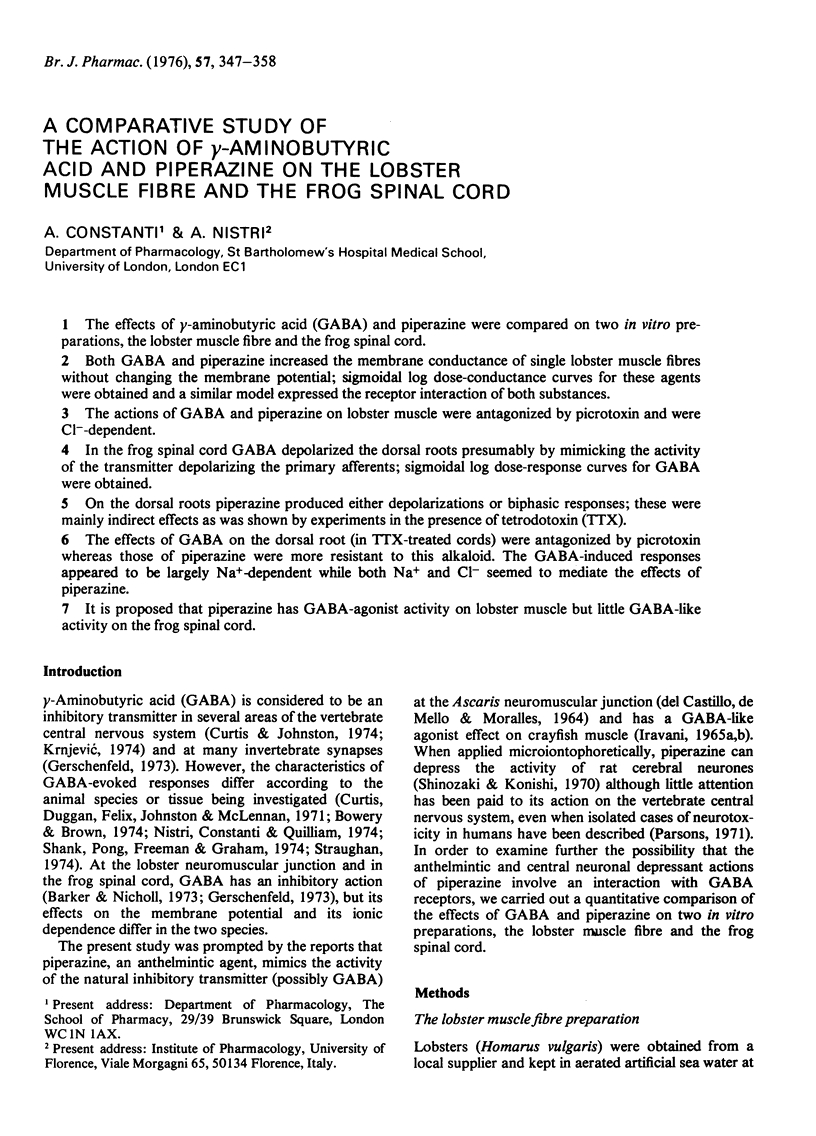
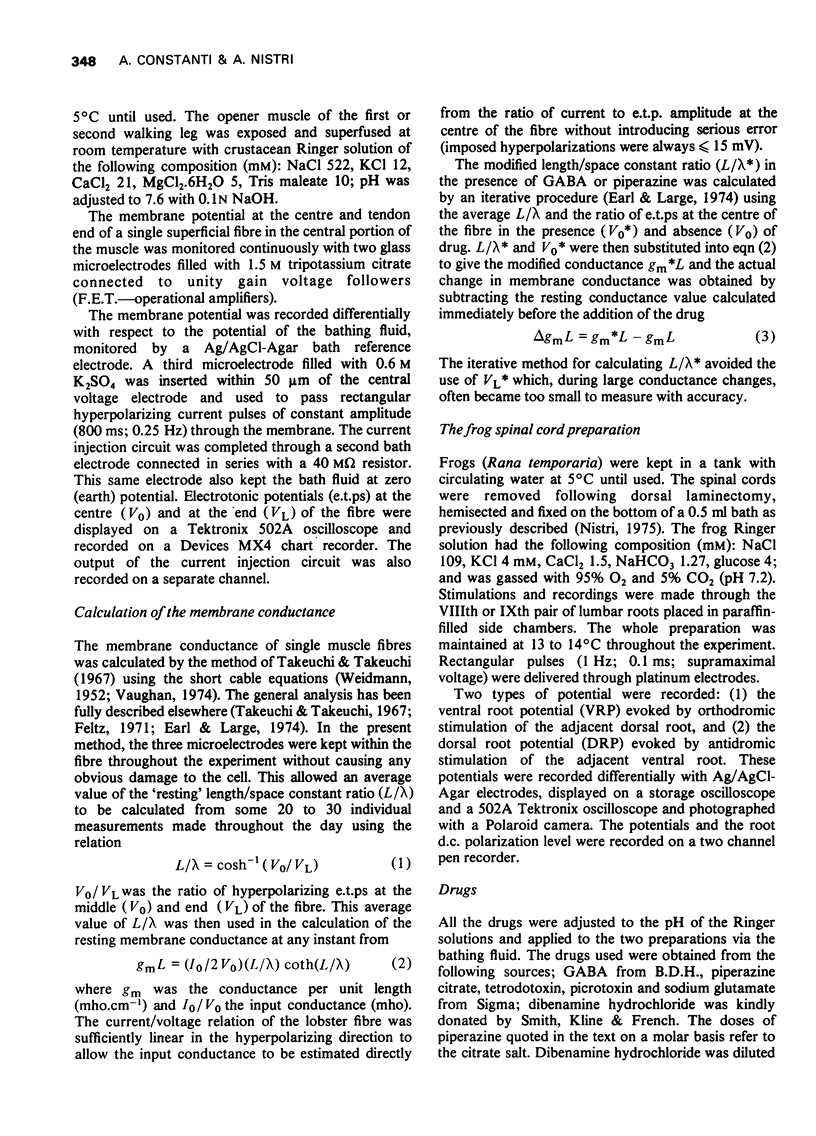



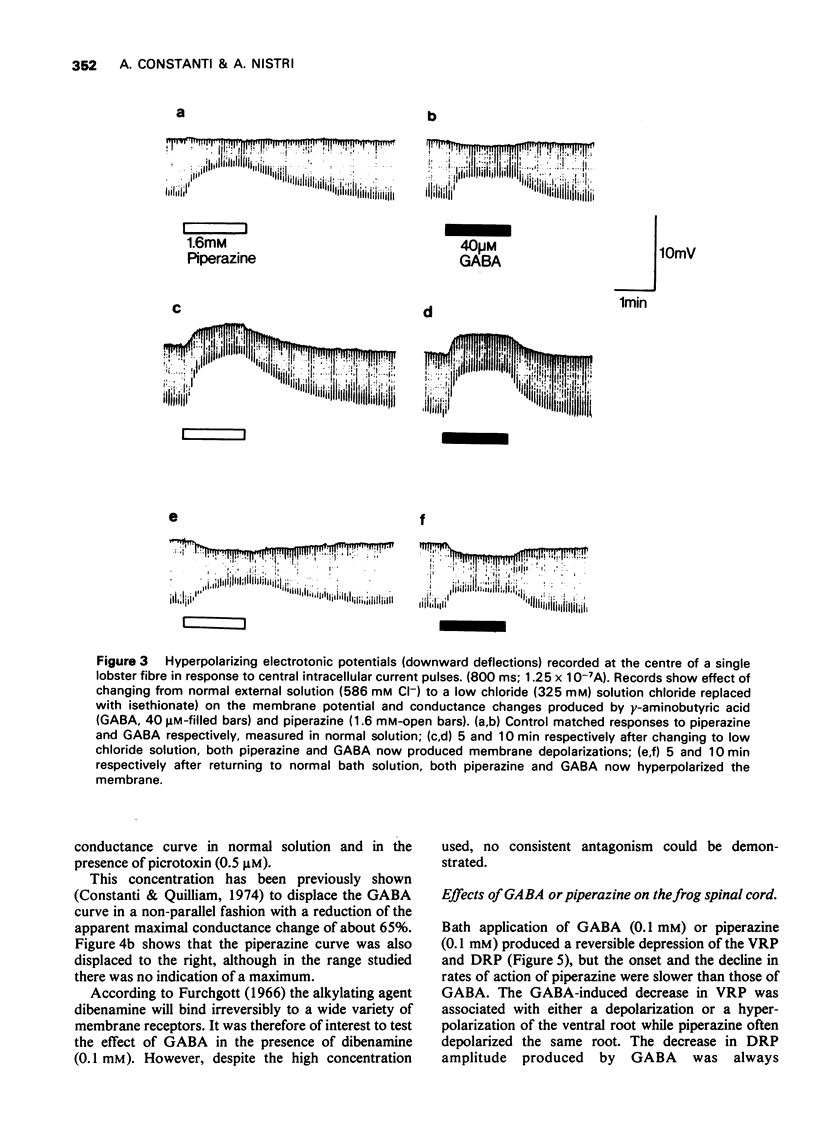


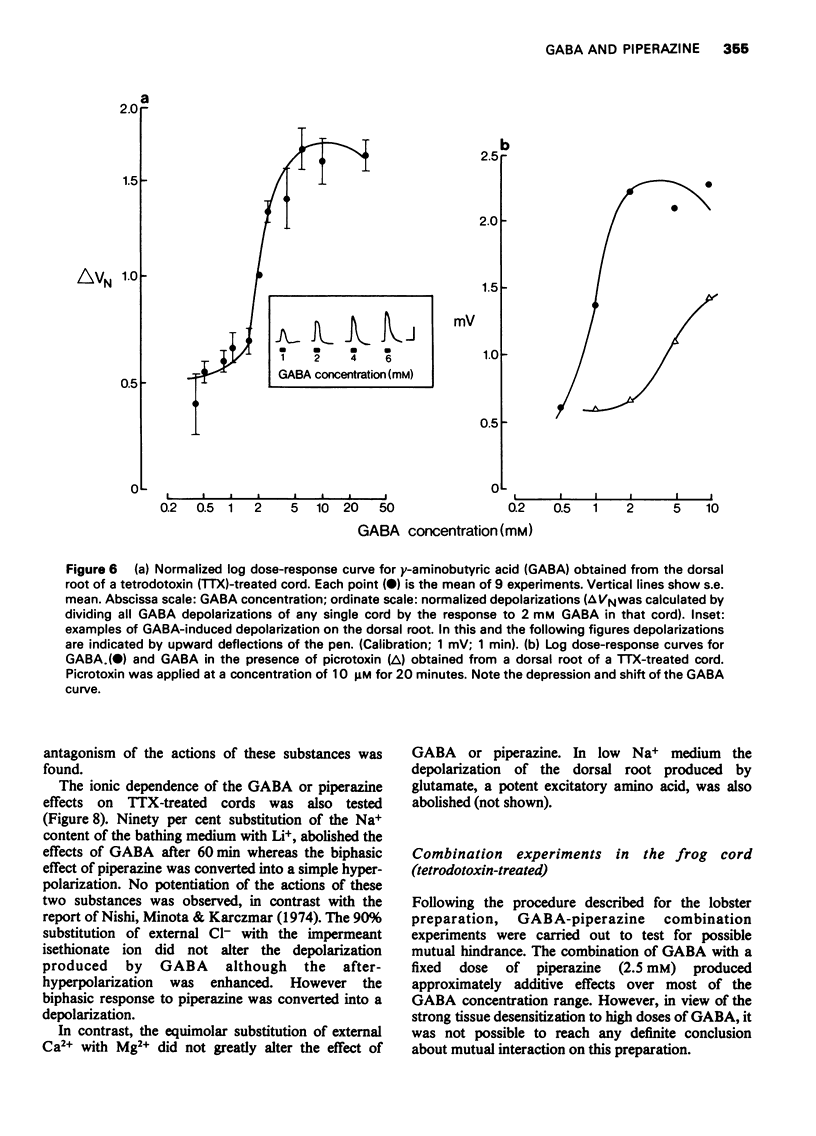
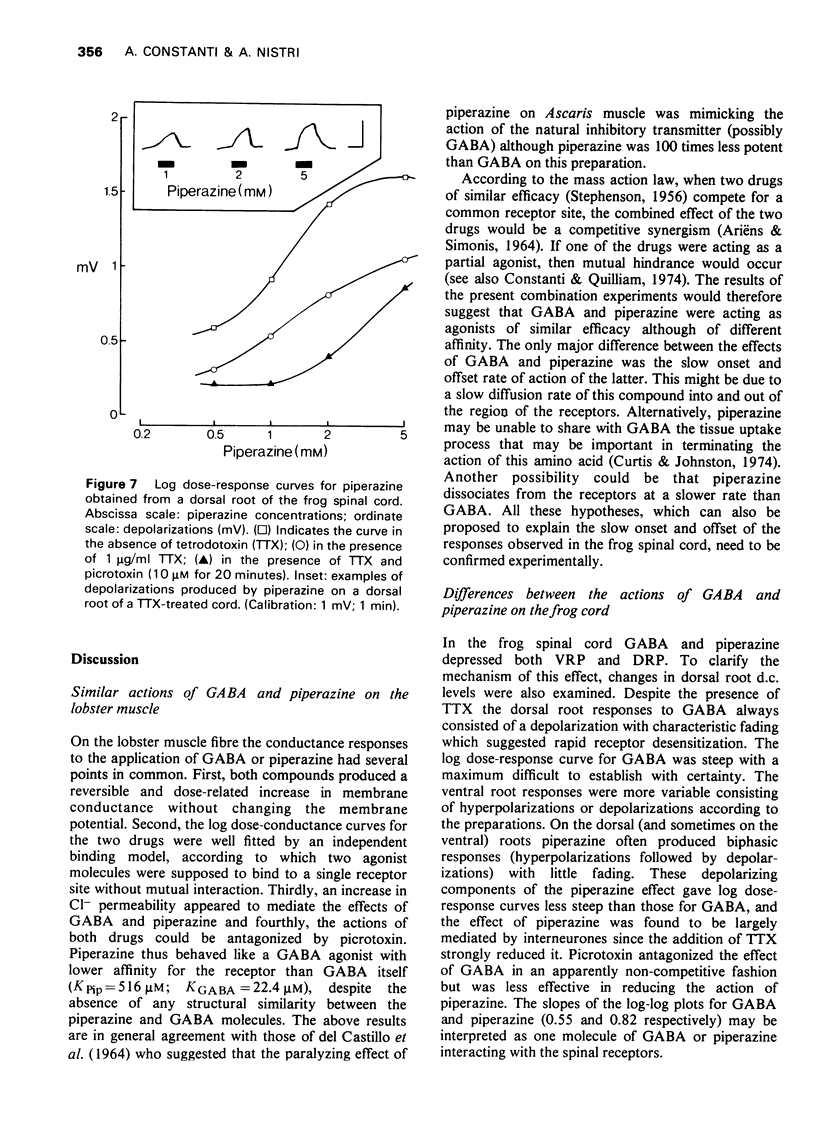


Selected References
These references are in PubMed. This may not be the complete list of references from this article.
- ARIUENS E. J., SIMONIS A. M. A MOLECULAR BASIS FOR DRUG ACTION. J Pharm Pharmacol. 1964 Mar;16:137–157. doi: 10.1111/j.2042-7158.1964.tb07437.x. [DOI] [PubMed] [Google Scholar]
- BOISTEL J., FATT P. Membrane permeability change during inhibitory transmitter action in crustacean muscle. J Physiol. 1958 Nov 10;144(1):176–191. doi: 10.1113/jphysiol.1958.sp006094. [DOI] [PMC free article] [PubMed] [Google Scholar]
- Barker J. L., Nicoll R. A. The pharmacology and ionic dependency of amino acid responses in the frog spinal cord. J Physiol. 1973 Jan;228(2):259–277. doi: 10.1113/jphysiol.1973.sp010085. [DOI] [PMC free article] [PubMed] [Google Scholar]
- Bowery N. G., Brown D. A. Depolarizing actions of gamma-aminobutyric acid and related compounds on rat superior cervical ganglia in vitro. Br J Pharmacol. 1974 Feb;50(2):205–218. doi: 10.1111/j.1476-5381.1974.tb08563.x. [DOI] [PMC free article] [PubMed] [Google Scholar]
- Constanti A., Quilliam J. P. A comparison of the effects of GABA and imidazoleacetic acid on the membrane conductance of lobster muscle fibres. Brain Res. 1974 Oct 18;79(2):306–310. doi: 10.1016/0006-8993(74)90422-3. [DOI] [PubMed] [Google Scholar]
- Curtis D. R., Duggan A. W., Felix D., Johnston G. A., McLennan H. Antagonism between bicuculline and GABA in the cat brain. Brain Res. 1971 Oct 8;33(1):57–73. doi: 10.1016/0006-8993(71)90305-2. [DOI] [PubMed] [Google Scholar]
- Curtis D. R., Johnston G. A. Amino acid transmitters in the mammalian central nervous system. Ergeb Physiol. 1974;69(0):97–188. doi: 10.1007/3-540-06498-2_3. [DOI] [PubMed] [Google Scholar]
- DELCASTILLO J., DEMELLO W. C., MORALES T. MECHANISM OF THE PARALYSING ACTION OF PIPERAZINE ON ASCARIS MUSCLE. Br J Pharmacol Chemother. 1964 Jun;22:463–477. doi: 10.1111/j.1476-5381.1964.tb01701.x. [DOI] [PMC free article] [PubMed] [Google Scholar]
- Earl J., Large W. A. Electrophysiological investigation of GABA-mediated inhibition at the hermit crab neuromuscular junction. J Physiol. 1974 Jan;236(1):113–127. doi: 10.1113/jphysiol.1974.sp010425. [DOI] [PMC free article] [PubMed] [Google Scholar]
- Feltz A. Competitive interaction of beta-guanidino propionic acid and gamma-aminobutyric acid on the muscle fibre of the crayfish. J Physiol. 1971 Jul;216(2):391–401. doi: 10.1113/jphysiol.1971.sp009531. [DOI] [PMC free article] [PubMed] [Google Scholar]
- Gerschenfeld H. M. Chemical transmission in invertebrate central nervous systems and neuromuscular junctions. Physiol Rev. 1973 Jan;53(1):1–119. doi: 10.1152/physrev.1973.53.1.1. [DOI] [PubMed] [Google Scholar]
- Iravani J. Wechselbeziehung von Barbituraten und Piperazin mit GABA an der Membran des Krebsmuskels. Naunyn Schmiedebergs Arch Exp Pathol Pharmakol. 1965 Jul 26;251(3):265–274. [PubMed] [Google Scholar]
- Nishi S., Minota S., Karczmar A. G. Primary afferent neurones: the ionic mechanism of GABA-mediated depolarization. Neuropharmacology. 1974 Mar;13(3):215–219. doi: 10.1016/0028-3908(74)90110-5. [DOI] [PubMed] [Google Scholar]
- Nistri A., Constanti A., Quilliam J. P. Letter: Central inhibition, G.A.B.A., and tutin. Lancet. 1974 May 18;1(7864):996–997. doi: 10.1016/s0140-6736(74)91311-7. [DOI] [PubMed] [Google Scholar]
- Nistri A., Constanti A. Some observations on the mechanism of action of baclofen (beta-chlorophenyl-gamma-amino-butyric acid). Experientia. 1975 Jan 15;31(1):64–65. doi: 10.1007/BF01924681. [DOI] [PubMed] [Google Scholar]
- Parsons A. C. Piperazine neurotoxicity: "worm wobble". Br Med J. 1971 Dec 25;4(5790):792–792. doi: 10.1136/bmj.4.5790.792. [DOI] [PMC free article] [PubMed] [Google Scholar]
- STEPHENSON R. P. A modification of receptor theory. Br J Pharmacol Chemother. 1956 Dec;11(4):379–393. doi: 10.1111/j.1476-5381.1956.tb00006.x. [DOI] [PMC free article] [PubMed] [Google Scholar]
- Shank R. P., Pong S. F., Freeman A. R., Graham L. T., Jr Bicuculline and picrotoxin as antagonists of gamma-aminobutyrate and neuromuscular inhibition in the lobster. Brain Res. 1974 May 31;72(1):71–78. doi: 10.1016/0006-8993(74)90651-9. [DOI] [PubMed] [Google Scholar]
- Shinozaki H., Konishi S. Actions of several anthelmintics and insecticides on rat cortical neurones. Brain Res. 1970 Dec 1;24(2):368–371. doi: 10.1016/0006-8993(70)90122-8. [DOI] [PubMed] [Google Scholar]
- Straughan D. W. Convulsant drugs: amino acid antagonism and central inhibition. Neuropharmacology. 1974 Jun;13(6):495–508. doi: 10.1016/0028-3908(74)90139-7. [DOI] [PubMed] [Google Scholar]
- Takeuchi A., Takeuchi N. A study of the action of picrotoxin on the inhibitory neuromuscular junction of the crayfish. J Physiol. 1969 Nov;205(2):377–391. doi: 10.1113/jphysiol.1969.sp008972. [DOI] [PMC free article] [PubMed] [Google Scholar]
- Takeuchi A., Takeuchi N. Anion permeability of the inhibitory post-synaptic membrane of the crayfish neuromuscular junction. J Physiol. 1967 Aug;191(3):575–590. doi: 10.1113/jphysiol.1967.sp008269. [DOI] [PMC free article] [PubMed] [Google Scholar]
- Vaughan P. C. Muscle membrane. Prog Neurobiol. 1975;3:219–250. [PubMed] [Google Scholar]
- WEIDMANN S. The electrical constants of Purkinje fibres. J Physiol. 1952 Nov;118(3):348–360. doi: 10.1113/jphysiol.1952.sp004799. [DOI] [PMC free article] [PubMed] [Google Scholar]
- Werman R. An electrophysiological approach to drug-receptor mechanisms. Comp Biochem Physiol. 1969 Sep 15;30(6):997–1017. doi: 10.1016/0010-406x(69)91038-x. [DOI] [PubMed] [Google Scholar]


